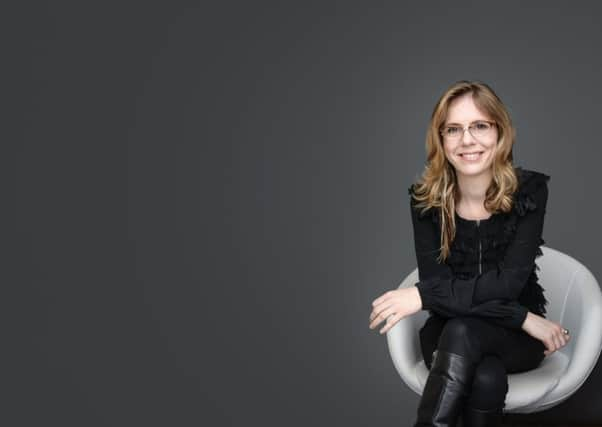Composer Anna Clyne sketches out her plans for working with the SCO


When Clyne composed Night Ferry for the Chicago Symphony Orchestra in 2012, for instance, she began by painting a series of two-foot panels evoking the visceral power of a dark turbulent wave, while the title comes from a poem by by Seamus Heaney. As for those dancing shoes, Clyne has a pair of wireless headphones that allow her to test the music on the move as she writes it. “If I can dance to it, it feels right,” she says. “Night Ferry was a very symbiotic relationship between the visual and the music,” the London-born composer explains. “It was also a structural device, each panel on my wall representing three minutes of music. I knew the structure was going to be key, and I knew the graphic representation gave me the necessary shape.”
The Chicago Tribune declared Night Ferry, written as part of Clyne’s five-year residency with the Chicago orchestra, “an absorbing, elegantly crafted work.”
Advertisement
Hide AdAdvertisement
Hide AdWorking in such a collaborative way has become central to the success Clyne enjoys from her New York base, the consequence, she believes, of the broadly-structured teaching she received as an undergraduate in Edinburgh and Canada, and as a postgraduate in Manhattan.
Her infatuation with New York began on a visit between finishing her exchange year at Queen’s University, Ontario and returning to Edinburgh to complete her degree. “I had this long break, so came back via New York and spent the summer waitressing, playing the cello in a rock band, and meeting so many people from all walks of life and all sorts of artistic fields. In the same way that I’d been drawn to Edinburgh for its vibrancy, it was like that times-a-thousand with New York.”
Since moving there, she’s worked around the US and abroad, as resident composer with Marin Alsop and the Baltimore Symphony Orchestra, in Europe with the Orchestra National d’Ile-de-France, on a recently completed residency with the Berkeley Symphony, and now collaborating with New York’s Orchestra of St Luke’s, as mentor on its groundbreaking composer programme, the DeGaetano Composition Institute.
Next month, however, Clyne returns to Scotland for the start of a new three-year posting as the Scottish Chamber Orchestra’s associate composer, and a launch programme featuring two of her works, notably the world premiere of Sound and Fury.
In this symphonic work, she’s turned to Shakespeare, got up close and personal with Haydn, and test-danced every bar. It features alongside her earlier double violin concerto Prince of Colours, directed and performed by Finnish violinist Pekka Kuusisto, with SCO leader Benjamin Marquise Gilmore as fellow soloist.
Clyne cites multiple inspirations. “Sound and Fury is based on two art references. One is Haydn’s Symphony No 60 Il Distratto [conceived originally as incidental music to a comic theatre piece about an absent-minded man]; the other is from Macbeth, the soliloquy he recites after learning of his wife’s death, and containing the words ‘told by an idiot full of sound and fury’.”
With the Haydn also featuring in the programme, listeners can hear the connection for themselves.
Advertisement
Hide AdAdvertisement
Hide Ad“The Haydn is in six movements; my piece is in a single movement with six subsections,” Clyne explains, adding that she listened repeatedly to the Haydn, jotted down rhythmic, melodic and harmonic ideas that grabbed her attention, “then just expanded these within the piece”.
And what of Haydn’s little joke, mimicking absent-minded moments by getting stuck on the odd chord? Absolutely, she says. “I play a lot with exaggerating that, having the strings glissando between small pitch ranges, for instance, then gradually expanding into big slides. It’s like zooming in on one element of the Haydn and taking it to a new dimension.”
What has excited Clyne is her new collaboration with the SCO players themselves. That’s a luxury for a composer, she says, even if much of the interaction has to be done over the phone. “I really wanted this piece to have some virtuosic elements, like a concerto for orchestra. They’ve helped me with that.”
Clyne is working on two further new works for SCO forces. “I’m writing a wind octet for next summer, inspired by the Scottish coastline and recognising the Scottish Government’s Year of Coastal Waters. I’m also writing an a cappella piece for the SCO Chorus, to be premiered next season as part of Greyfriars Kirk’s 400th anniversary.” Ken Walton
The SCO premiere Sound and Fury at the Queen’s Hall, Edinburgh on 7 November, and City Halls, Glasgow, on 8 November, www.sco.org.uk